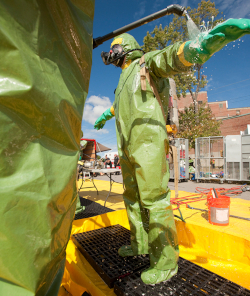Decontamination Procedures
Decontamination procedures must provide an organized process by which levels of contamination are reduced.
The decontamination process should consist of a series of procedures performed in a specific sequence. For example, outer, more heavily contaminated items (e.g., outer boots and gloves) should be decontaminated and removed first, followed by decontamination and removal of inner, less contaminated items (e.g., jackets and pants). Each procedure should be performed at a separate station to prevent cross contamination.
The sequence of stations is called the decontamination line.
- Stations should be separated physically to prevent cross contamination and should be arranged in order of decreasing contamination, preferably in a straight line.
- Separate flow patterns and stations should be provided to isolate workers from different contamination zones containing incompatible wastes.
- Entry and exit points should be conspicuously marked, and the entry to the Contamination Reduction Zone (CRZ) from the Exclusion Zone should be separate from the entry to the Exclusion Zone from the CRZ.
- Dressing stations for entry to the CRZ should be separate from redressing areas for exit from the CRZ.
- Personnel who wish to enter clean areas of the decontamination facility, such as locker rooms, should be completely decontaminated.
Knowledge Check Choose the best answer for the question.
4-3. Why should decontamination stations be separated physically?
You forgot to answer the question!

